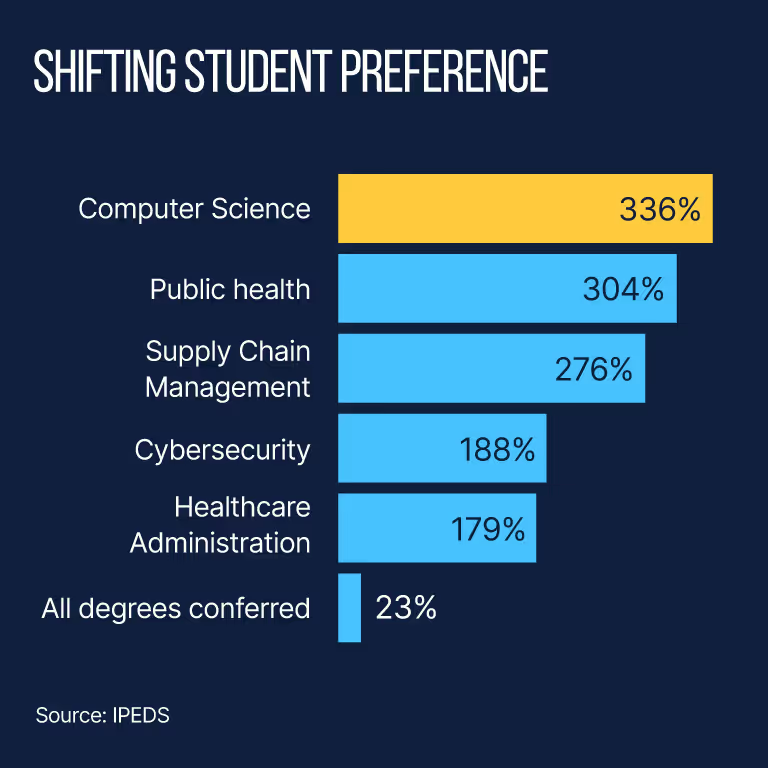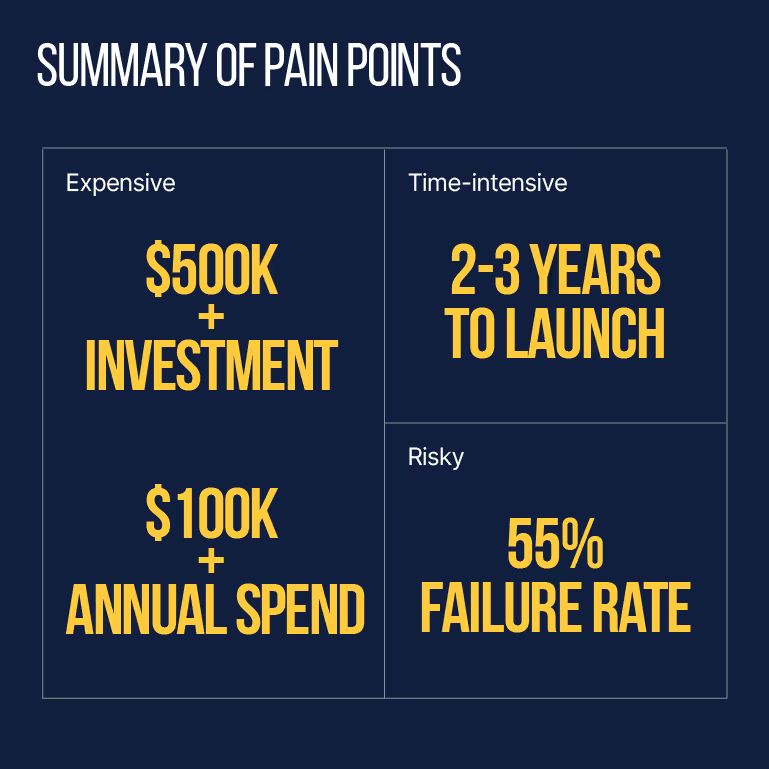Why don’t colleges start new majors more often?
The decision to start new majors every year seems like it should be simple: according to sources like the Lumina Foundation, 93% of students list “available majors” as one of the most important reasons they choose a college (or don’t!).

Value of New Majors
The decision to start new majors every year seems like it should be simple: according to sources like the Lumina Foundation, 93% of students list “available majors” as one of the most important reasons they choose a college (or don’t!).

Not only are majors offered the most important factor, but new subjects like Cybersecurity and Data Analytics have exploded into multi-billion dollar industries in a world that didn’t have them just 20 years ago. And, where available, students are opting to get these degrees over declining degrees like English and History.

Challenges Starting Programs
So why doesn’t every college offer them? Why don’t colleges start new majors more frequently? Ask any Provost and the answer will be any combination of three things.
- It’s expensive
- It’s time-intensive
- And it’s risky

In order to better understand the complexities of getting each of these reasons, we need to dig deep. The first two challenges, cost and time, are two sides of the same coin, both with roots in the program development cycle.
Program Development Cycle
The program development cycle can be broken down into 4 stages.
First, there's research–identifying programs. Even identifying the right program can cost $20,000 in time, consulting fees and database seats. Schools need to analyze which programs neighbors and peers have, what the regional labor market demand for related jobs are, and whether it is possible to employ and attract interested faculty and students.
Once the appropriate programs are identified, it is time to hire talent and develop the curriculum. To build out curriculum, a school often has to attract talent away from what is likely a lucrative professional field. As an example, the average Cybersecurity professional makes $112,974. Increasing salary to try and bridge the gap is expensive and can take many months in search. That time in search, combined with the salary expense during the ~2-3 semesters that the program is being built, can bring the cost of stage two to $350,000 or more according to sources like Burning Glass and EAB.
By stage three, the curriculum prep is done and an enrollment marketing team works to build out materials, a knowledge base, and a prospective student outreach strategy. The team has to ensure students fill the seats necessary to, at a minimum, pay off the cost of running the program. Sprinting through an enrollment cycle to fill those seats can take 2 semesters to get off the ground and 4 semesters to perfect. All-in, while often not measured directly, the labor and resource costs can run into the hundreds of thousands as well.
Finally, there’s the cost of running a new degree program year in and year out. A full time faculty member, plus adjuncts, on-going marketing, updating curriculum, ensuring students persist, etc–for many schools these ongoing costs come out to $100-200K a year on the low end.
And that’s where the risk comes in.
Risks in Program Development
According to an analysis from Burning Glass, the majority of new degrees started by private colleges don’t graduate more than 5 students a year. That means many new academic degree programs never actually enroll enough students to offset the upfront and ongoing costs and make a new program financially sustainable.
All in all, creating new academic programs can result in a lot of pain points for a university which is already worried about costs. The last thing the institution wants is to increase costs for a losing program and risk passing the higher costs on to students through higher tuition!

Solutions
Fortunately, when a problem gets this big, there are a ton of great minds working on answers. Below are 3 solutions that are starting to find traction across the country.
- Build off of Strengths
Program development should often start with an assessment of what an institution already does well. Which programs already attract a large number of students and employer interest? An existing strong program often means both valuable resources and brand to leverage for a new program. Said differently, programs that leverage an existing strength can cost less to build and to market because of the existing infrastructure at your institution. For example, a new business specialization like Supply Chain Management can be built with relatively few courses if you have a high-performing existing department. Strategically moving into entirely new areas should not be discounted - many smaller institutions are still missing out on the tremendous growth in high-cost STEM majors. But colleges should start with low-cost, high-impact majors before moving to high-cost, high-impact majors.
- Online Program Managers (OPMs)
Another path many colleges have taken to reduce the upfront cost and time associated with program development is working with OPMs. The word OPM tends to be a lightning rod in higher education, but the model of shifting risk and some expertise onto the OPM has been a viable model for some institutions. For many institutions, however, the large revenue share, sole focus on online and long-term contracts prohibit using OPMs.
- Premium Course Sharing
Rather than signing 10+ year contracts and agreeing to give up the majority of revenue in a partnership, Premium Course Sharing allows colleges to build new majors for a smaller fixed annual fee. By accessing curriculum in specialized fields shared across a consortium of colleges, institutions can quickly build and maintain programs for a fraction of the traditional cost. With shorter-term contracts (often 3 years) and less upfront cost, smaller institutions can successfully operate high-margin majors by recruiting just a few new students each year.
Summary
Despite high demand in new, emerging fields, colleges don’t start new majors every year because of the high-cost associated with research and development of curriculum, staffing costs, and the risk that enrollment numbers never offset those costs. That said, there are solutions–including premium course sharing–that allow colleges and universities to start new programs in approximately 1 semester for one-tenth the cost of the traditional model.

Why don’t colleges start new majors more often?
The decision to start new majors every year seems like it should be simple: according to sources like the Lumina Foundation, 93% of students list “available majors” as one of the most important reasons they choose a college (or don’t!).
Value of New Majors
The decision to start new majors every year seems like it should be simple: according to sources like the Lumina Foundation, 93% of students list “available majors” as one of the most important reasons they choose a college (or don’t!).

Not only are majors offered the most important factor, but new subjects like Cybersecurity and Data Analytics have exploded into multi-billion dollar industries in a world that didn’t have them just 20 years ago. And, where available, students are opting to get these degrees over declining degrees like English and History.

Challenges Starting Programs
So why doesn’t every college offer them? Why don’t colleges start new majors more frequently? Ask any Provost and the answer will be any combination of three things.
- It’s expensive
- It’s time-intensive
- And it’s risky

In order to better understand the complexities of getting each of these reasons, we need to dig deep. The first two challenges, cost and time, are two sides of the same coin, both with roots in the program development cycle.
Program Development Cycle
The program development cycle can be broken down into 4 stages.
First, there's research–identifying programs. Even identifying the right program can cost $20,000 in time, consulting fees and database seats. Schools need to analyze which programs neighbors and peers have, what the regional labor market demand for related jobs are, and whether it is possible to employ and attract interested faculty and students.
Once the appropriate programs are identified, it is time to hire talent and develop the curriculum. To build out curriculum, a school often has to attract talent away from what is likely a lucrative professional field. As an example, the average Cybersecurity professional makes $112,974. Increasing salary to try and bridge the gap is expensive and can take many months in search. That time in search, combined with the salary expense during the ~2-3 semesters that the program is being built, can bring the cost of stage two to $350,000 or more according to sources like Burning Glass and EAB.
By stage three, the curriculum prep is done and an enrollment marketing team works to build out materials, a knowledge base, and a prospective student outreach strategy. The team has to ensure students fill the seats necessary to, at a minimum, pay off the cost of running the program. Sprinting through an enrollment cycle to fill those seats can take 2 semesters to get off the ground and 4 semesters to perfect. All-in, while often not measured directly, the labor and resource costs can run into the hundreds of thousands as well.
Finally, there’s the cost of running a new degree program year in and year out. A full time faculty member, plus adjuncts, on-going marketing, updating curriculum, ensuring students persist, etc–for many schools these ongoing costs come out to $100-200K a year on the low end.
And that’s where the risk comes in.
Risks in Program Development
According to an analysis from Burning Glass, the majority of new degrees started by private colleges don’t graduate more than 5 students a year. That means many new academic degree programs never actually enroll enough students to offset the upfront and ongoing costs and make a new program financially sustainable.
All in all, creating new academic programs can result in a lot of pain points for a university which is already worried about costs. The last thing the institution wants is to increase costs for a losing program and risk passing the higher costs on to students through higher tuition!

Solutions
Fortunately, when a problem gets this big, there are a ton of great minds working on answers. Below are 3 solutions that are starting to find traction across the country.
- Build off of Strengths
Program development should often start with an assessment of what an institution already does well. Which programs already attract a large number of students and employer interest? An existing strong program often means both valuable resources and brand to leverage for a new program. Said differently, programs that leverage an existing strength can cost less to build and to market because of the existing infrastructure at your institution. For example, a new business specialization like Supply Chain Management can be built with relatively few courses if you have a high-performing existing department. Strategically moving into entirely new areas should not be discounted - many smaller institutions are still missing out on the tremendous growth in high-cost STEM majors. But colleges should start with low-cost, high-impact majors before moving to high-cost, high-impact majors.
- Online Program Managers (OPMs)
Another path many colleges have taken to reduce the upfront cost and time associated with program development is working with OPMs. The word OPM tends to be a lightning rod in higher education, but the model of shifting risk and some expertise onto the OPM has been a viable model for some institutions. For many institutions, however, the large revenue share, sole focus on online and long-term contracts prohibit using OPMs.
- Premium Course Sharing
Rather than signing 10+ year contracts and agreeing to give up the majority of revenue in a partnership, Premium Course Sharing allows colleges to build new majors for a smaller fixed annual fee. By accessing curriculum in specialized fields shared across a consortium of colleges, institutions can quickly build and maintain programs for a fraction of the traditional cost. With shorter-term contracts (often 3 years) and less upfront cost, smaller institutions can successfully operate high-margin majors by recruiting just a few new students each year.
Summary
Despite high demand in new, emerging fields, colleges don’t start new majors every year because of the high-cost associated with research and development of curriculum, staffing costs, and the risk that enrollment numbers never offset those costs. That said, there are solutions–including premium course sharing–that allow colleges and universities to start new programs in approximately 1 semester for one-tenth the cost of the traditional model.

